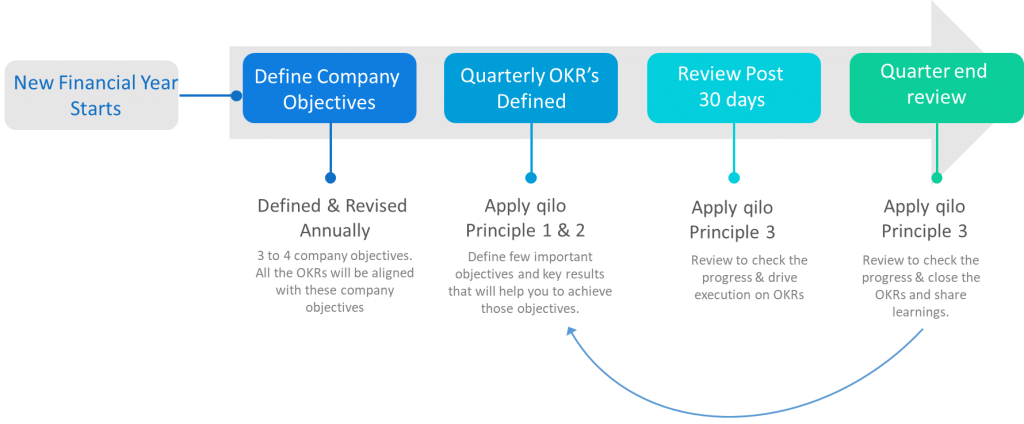Objectives and Key Results


OKRs (Objectives and Key Results) are a planning methodology based on establishing objectives in an open and collaborative way, which can be applied to all types of organizations, teams, and individuals.
OKRs force the organization to identify and prioritize a limited number of objectives to be achieved in a period of time. These objectives are accompanied by a series of quantitative indicators that allow us to see at all times how close or far we are from achieving them. This common purpose helps enormously to channel everyone’s efforts and to provide unity to the entire organization.
This methodology is currently used not only by technology companies such as Google, Dropbox, LinkedIn, Oracle, Slack, Spotify, and Twitter, but also companies in other sectors such as Anheuser-Busch, BMW, Disney, Exxon, Samsung, and the Bill and Melinda Gates Foundation.
OKRs History
Taylor and Ford brought to life the scientific management theories in the 20th century. These frameworks were applied mainly to the first factories with chain production, consisting of “knowing exactly what you want your men to do and then making sure they do it in the cheapest and most efficient way”.
Some decades after that, Peter Drucker, professor, journalist, and historian, set out to demolish the Taylor-Ford model. He did so by creating a new management ideal that was equally results-driven but more humane. In his studies, he stated that a corporation should be a community “based on trust and respect for workers, not just a profit-making machine”. He insisted that subordinates should be consulted on the objectives of the company.

The OKR-based management philosophy was created by Andy Grove at semiconductor manufacturer Intel in the late 1970s. It has become immensely popular – especially in technology companies and startups – since Google introduced it in 1999 at the suggestion of John Doerr. Doerr, one of the most legendary figures in the history of VC, learned the methodology from Grove himself during an internship with Intel. Since then, he has become one of the main promoters of the methodology, proposing its implementation in all the companies he has worked for or invested in.
What are OKRs?

An OKR is a combination of an objective and key results associated with the objective. It aims to help us visualize what success is and understand if we are getting closer.
The objective refers to what is to be achieved. It is something concrete, which calls for action and which is ambitious and inspiring. This is very important because if the goal is not challenging enough people will not be motivated about achieving it. However, if the objective is too ambitious people will think it is impossible. Hereinafter, if the team completes about 80% of the objectives it will be a great success.
A key result has to do with how we are going to achieve a goal while serving as a benchmark for its completion. Effective key results need to be specific and set in a time frame, they need to be aggressive and at the same time realistic. Above all, they must be measurable and verifiable. It is commonly said that “if it does not include a figure, it is not a key result”. A key result is either met or not met. There is no middle ground and there is no doubt about it. At the end of the designated period, the key result is declared as “achieved” or “not achieved”. Just as a goal can be extended over time and last for a year or more, key results evolve as work progresses. Once all key results have been completed, the objective must be achieved.

Let’s use as an example of the OKR that Rahul Vohra, founder of San Francisco-based startup Superhuman, used to achieve Product-Market Fit (PMF):
OBJECTIVE: Validate Value Proposition through PMF
KEY RESULTS:
- >40% of users answer “very disappointed” when asked, “How would you feel if you could no longer use the product?”
- Use Pareto Law to identify common characteristics of your 20% best customers and focus the analysis on them.
- Use Pareto Law to identify the 20% most valued characteristics of your product and focus the analysis on customers that value them.
Benefits from adopting OKRs
It has already been seen the flexibility and adaptive capability from adopting embracing this practice, now it is time to cover the attributes that can arise within companies as a result of an adequate process of progressive adjustment and implementation.
Principles of the system
The OKR methodology proposes a quarterly cadence, in order to better adapt to the rhythm of rapidly changing markets.
In each cycle, OKRs should be limited to a number between three and five per level. In turn, each objective must be linked to a maximum of five key results.
Two of the most important pillars of the OKR methodology are that they are totally transparent – anyone at any level can know what the objectives of any other are and see their degree of compliance – and that their method of fixation is collaborative, with strong bottom-up component. OKRs are not dictated by the upper hierarchical layers, they are a cooperative social contract to set priorities and define how to quantify progress.
There are certain obligatory OKRs and others that are more aspirational, which push people to achieve what a priori seems impossible. At Google, only 40% of the latter are expected to be met.
OKRs must be unrelated to the remuneration policy or constitute only a small part of it. Any system linked to remuneration invites trickery and encourages conservatism. In Google’s case, OKRs account for less than a third of performance evaluations. However, the OKRs can be taken into account when deciding on a promotion, since they allow you to see at all times who have contributed the most to achieving the company’s objectives. Audacity, responsible risk-taking, and contribution to the common mission are rewarded. It soon becomes clear that the individuals who are promoted are the ones doing what the company values the most. The organization’s poisons, that is, misgivings, immobility, and personal politics, lose their toxic power.
Establishment process
Senior management is responsible for setting OKRs at the company level, as well as setting their own personal goals. All managers are expected to be doers as well and lead by example. In order for sound decision making, team spirit, and exceptional performance to be achieved, the entire organization must understand the company’s goals. And for this, it is essential that leaders express both WHAT and WHY. After agreeing on the most important objectives for the quarter, the management team presents itself to its collaborators and says: “This is what we think matters and these are the reasons that lead us to think about it.”
Once OKRs have been set at the company level, all other divisions, departments, teams and individuals are invited to formulate their own OKRs.
To promote engagement, teams and partners are free to set at least some of their goals – roughly half – and virtually all of their key results. Each division, department, team, individual, etc. It is responsible for setting 3-5 OKRs that contribute both to the achievement of the objectives of the higher levels and to that of their own objectives. Everyone is invited to contribute to the achievement of global goals with what they think they can do best. The result will be visible to everyone.
Each party is free to propose what seems best to them. It is then negotiated and iterated — vertically and horizontally with supervisors, collaborators, and peers — until all the pieces fit together and all the parties agree. It can be a somewhat complex task – especially the larger and more hierarchical the organization – but the result is worth it. The perfect should not be allowed to be the enemy of the good. An OKR can be modified or even discarded at any point in the cycle
Follow-up process
OKRs are based on data. They are driven by periodic reviews, evaluation of objectives, and continual rethinking, all following a spirit of responsibility in which no value judgments are made. The bosses meet weekly with their collaborators to review the progress status of their OKR. Progress is reported, obstacles are identified and key results are refined.
In addition to individual reviews, teams and departments hold regular meetings to assess how progress is being made towards shared goals. If conditions change and a goal is no longer practical or has become irrelevant, key results may change or even be discarded mid-cycle. When an assigned OKR is in distress, a rescue plan is drawn up.
The simplest and cleanest way to score a goal is to average the percentage of completion scores associated with it. Google uses a scale from 0 to 1.0:
- 0.7 to 1.0 = green (goal accomplished)
- 0.4 to 0.6 = yellow (progress is being made, but we have not reached the goal)
- 0.0 to 0.3 = red (we have not managed to make real progress)
As we track our OKRs, we will have four options at any point in the cycle:
- Continue: If a target is marked with green (“as programmed”) there is no problem, so there is no need to modify it.
- Update: Modify a target or key result marked in yellow (“needs attention”) to respond to changes in workflow or external environment. What could we change so that the objective progresses as scheduled? Should we review the deadlines? Should other initiatives that free up resources to implement that be put in the background?
- Get started: Establish a new OKR mid-cycle whenever the need arises.
- Stop: When a target that is marked in red (“at-risk”) has lost its usefulness, the best solution may be to forget about it.
Implementation
Although an OKR system could be implemented in any office software, it would soon become too complicated to be able to consult it and update it regularly. Therefore, the use of some of the existing cloud software is recommended for the establishment and monitoring of OKRs. The best platforms in this regard contain mobile apps, automatic updating, analytical reporting tools, real-time alerts, and have Salesforce, JIRA, and Zendesk integrated.
Transition to OKRs from other methodologies
Any organization already sets and tracks goals somehow. OKRs can help with bringing structure, company-wide alignment, and focus. They will not disrupt already existing processes.
There are many benefits of implementing OKRs such as alignment, improved focus and employee engagement among others. The difference however between companies who succeed with OKRs and those who don’t is commitment.
The transition from another system requires compromise and a great deal of communication. Is it not about preparing an OKR list and reviewing it a couple of times, it’s about building the muscle of the organization & the development of such muscle is not a simple process.
In many occasions, the best practice is to introduce it in a gradual way. We shall not suddenly change from an annual cadence to a trimestral one, from private objectives to public ones, nor from a top-down process to a more collaborative one. It’s preferable to introduce these changes gradually.
Patience is key, every new process requires a trial and transition period. An organization might need from four to five cycles to get hold of the system and even more time to reinforce this muscle that works by objectives.
Attributes of the methodology
Attribute 1: Prioritization
Less is More. It is evident the huge variety of options that nowadays overcharge leaders’ heads when decision making is necessary, which makes it even more difficult. These aspects highlight the importance of establishing a focal point, as it was mentioned, this methodology is based on predefined time periods, so the right question for ourselves is: Which is the most relevant aim for us to accomplish in this period?.
The purpose of this question is to clarify which are the initiatives that would generate a real impact for our organization, and postpone those that do not meet these conditions. For this reason, OKRs proposes the setting of a limited number of objectives between three and five per period for the business, the departments, and the individual.
Attribute 2: Coordination and collaboration
The whole is better than the sum of its parts. OKRs is a synonym of transparency and conciliation, every part of the business should be willing to share with others their objectives, enforcing in this manner, the general objectives planned for the entity.
Transparency is the step before the collaboration, if a synergy is achieved between these two concepts, the establishment of enriching and productive relationships within the business workplace is assured, from the top to the base.
As Aristotle said, “Humans are social animals by nature”. The intention of this methodology is to create a well-linked network connecting all the different parts composing the organization to encourage mutual learning and the fulfillment of the general mission by linking everyone’s effort.
Attribute 3: Motivation and exigency
Bigger the objective, the higher the performance. A key aspect to take care of is the employees within our organization, the people who make everything work properly. Individuals need to feel the importance of their role within the general mission, they are more engaged when the tangible measurement of their contribution is visible, and how it contributes to achieving the company’s mission.
OKRs are planned for this purpose, as results of the work done well are visible monthly, weekly, or even daily. In addition, if each member is concerned about their successes and failures, they will be able to learn from it, as clear guidelines have been followed. Resultantly, it generates a snowball effect regarding the establishment and further efforts to adopt and go through more and more ambitious purposes.
Outcomes
OKRs are not going to solve all your problems related to strategy and organisation. No management system is. They cannot replace good judgment, good leaders, or creative company culture. But if you have that foundation on which to build them, OKRs can help you get to the top and bring your company to the next level (not recommendable for companies lacking of a solid and developed base from which implement OKRs).
It is fundamental to remark that both the company and each individual within the organisation could benefit from this methodology as it gives an extra motivation and path to follow to reach your short-term and long-term purposes; even the customer take advantage as the business activity and product development is more productive. However, as we have seen, it cannot be implemented anytime, it requires an adequate process of adaptation to progressively transition from your previous strategy (both the organisation as a whole and each member inside need it)
At the same time, some drawbacks could arise, as it could be difficult and hard to have a track about all the OKRs from the different components of the company, which leads to the impoverishment of coordination, and even, lacks transparency. In addition, it could be equally difficult to guarantee healthy relationships and the removal of conflict of interests. Therefore we created a google sheet, so you can take action with this OKRs template!
We find OKRs an effective concept as it gives you a highly flexible and adaptive capability regarding your business functioning and performance with perspective to your market, which opens the door to an enriching network between every area in the firm. It favors productivity, solidification of a strong base from which to grow up, and learning how to prioritize (and do not get stuck on aspects that do not suppose a real impact). These features are focal points maybe for any person-oriented to the business environment who wants to properly manage a group of people and become a real leader in a future, which is our case.
Also, there is the possibility to get certified on the topic. There are many places to do so, but we think that the best place to do it is in this link, which is the official site of the methodology: https://okrs.com/coaching-programs/okrs-certification/
We hope you find the topic as interesting and actionable as we did and to see how you will apply it as a software architect in the future. Remember to check the google sheet!

About the authors
Hamza L. I am a technology & business student, passionate about systems thinking and problem solving. I love working out and watching movies. @hzlk_
Juan D. Oliva. I am a Management and Technology student, interested in the digital business ecosystem and programming applied to the business world. My hobbies are working out and listening to music. @juanog22
Alejandro Recouso. I am a Management and Technology student and Spanish entrepreneur. I am passionate about startups and innovative business models. I spent my free time working out and improving myself through self-education. Follow me on Twitter @alexrecouso
Pablo Monteoliva, Management and Technology student, currently learning front-end development and design. Also creating a community around personal development and startups in my newsletter & podcast (https://pablomonteoliva.substack.com/). If you want to get in touch probably twitter is the best way! @MonteolivaPablo
Antonio Balanza. Currently studying in the university and learning on my own. Passionate about technological business, philosophy and politics. Check my twitter for learning more about me @de_balanza

